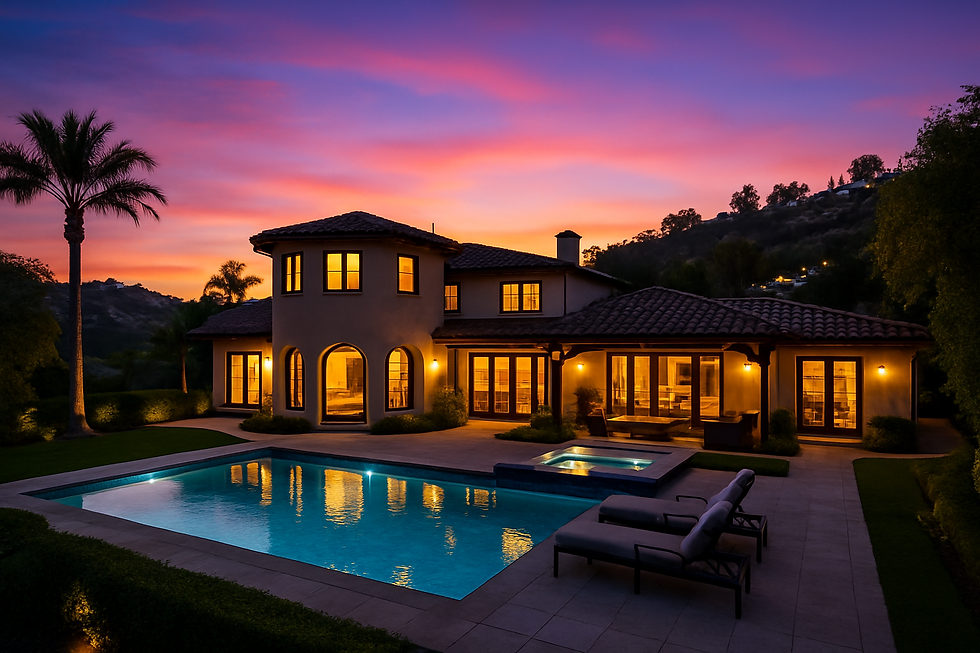Photography Mistakes That Cost Real Estate Agents Sales
- Fourth Wall Production

- Sep 18
- 4 min read

In real estate, first impressions aren’t made at the open house, they’re made online. More than 95% of buyers begin their home search on the internet, scrolling through photos before they ever call an agent. That means your property photos aren’t just decoration, they’re sales tools.
High-quality real estate photography can make a modest listing look appealing, while poor photography can sabotage even the most desirable property.
Below are the most common mistakes agents make and how to avoid them with help from professionals like Fourth Wall Production’s real estate media services.
------------ Advertisement ------------
1. Poor Lighting
The problem: Dark, dim, or unevenly lit rooms make spaces feel small, uninviting, and even a little depressing. On the flip side, overly harsh lighting, such as blasting a room with direct flash, creates unflattering shadows and a sterile, clinical feel.
The fix:
Shoot during the day when natural light is strongest.
Open blinds and curtains to bring in sunshine.
Use soft, diffused artificial lighting to balance the scene.
Avoid shooting directly into bright windows without adjusting exposure.
Lighting should flatter the property, not fight it.
2. Overusing Wide-Angle Lenses
The problem: A wide-angle lens is standard in real estate photography because it helps capture entire rooms. But when overused or used incorrectly, it creates distortion. Walls curve, furniture stretches, and rooms look unnaturally large. Buyers show up expecting a ballroom and find a shoebox.
The fix:
Use wide-angle lenses sparingly and with care.
Keep vertical lines (like door frames) straight during editing.
Balance “showing the space” with “showing it accurately.”
Honest representation builds trust and trust sells.
3. Messy or Cluttered Rooms
The problem: No matter how stunning the architecture, clutter kills buyer interest. A sink full of dishes, tangled cords, pet toys, or too many personal items distract buyers from the home itself.
The fix:
Schedule a quick declutter before shooting.
Hide trash bins, remotes, shoes, and excess décor.
For occupied homes, stage rooms with minimal, neutral furnishings.
Buyers need to picture their life in the space, not yours.
4. Ignoring Curb Appeal
The problem: Agents often focus on interiors while neglecting exterior shots. But the front photo is usually the thumbnail image buyers see first. A poorly framed, shadow-covered, or overexposed exterior shot can tank interest before they click.
The fix:
Photograph the exterior when the lighting is soft (early morning or late afternoon).
Ensure cars, garbage bins, and people are out of the shot.
Capture different angles to highlight landscaping, porches, and entryways.
The front shot is your “handshake photo” therefore, make it strong.
5. Bad Angles and Crooked Shots
The problem: Photos taken from odd angles, too low, too high, or tilted, make rooms look awkward. Crooked lines (like a slanted horizon or off-balance doorway) make photos look amateurish.
The fix:
Keep the camera at chest height for interiors.
Use a tripod to steady shots.
Align vertical and horizontal lines carefully in editing.
Clean, level shots look professional and reliable.
------------ Advertisement ------------
6. Skipping Detail Shots
The problem: Agents sometimes post only room-wide shots and forget the details. Buyers want to see unique features: a farmhouse sink, a fireplace mantel, or custom built-ins. Leaving these out makes listings forgettable.
The fix:
Take close-ups of selling points.
Use detail photos to break up wide shots in the gallery.
Highlight upgrades that justify the price.
Think of detail shots as your property’s “selling sound bites.”
7. Over-editing or Fake-Looking Photos
The problem: Yes, editing is essential. But oversaturated colors, fake blue skies, or unrealistic virtual staging turn buyers off. Worse, heavily Photoshopped images can make the home feel like a bait-and-switch.
The fix:
Use editing to enhance, not deceive.
Adjust brightness, contrast, and color naturally.
Be transparent about virtually staged photos.
Buyers value authenticity, they’ll trust you more if your photos look like the real thing.
8. Ignoring Vertical Spaces
The problem: Many agents focus only on floor-level shots, forgetting to showcase ceilings, light fixtures, or tall windows. Rooms can end up looking flat and less impressive than they really are.
The fix:
Include a few vertical shots where ceiling height is a selling point.
Capture features like crown molding or skylights.
Balance horizontal and vertical perspectives.
Show the full volume of the space not just the square footage.
9. Forgetting to Clean Windows and Mirrors
The problem: Smudges, streaks, or reflections of the photographer in mirrors and glass scream “unprofessional.” They also distract buyers.
The fix:
Clean reflective surfaces before shooting.
Angle shots to avoid capturing your reflection.
Use polarizing filters to minimize glare.
A spotless photo reads as a well-maintained home.
10. Posting Too Few Photos
The problem: A listing with only five photos tells buyers two things: (1) there’s something to hide, or (2) the agent didn’t care enough. Either way, buyers move on.
The fix:
Aim for 20–30 high-quality photos for an average home.
Include every major room, exterior shots, and detail highlights.
More photos = more time buyers spend with your listing.
Think of your gallery as a guided tour, not a teaser.
11. Overlooking Seasonal Factors
The problem: Snow-covered lawns, dead trees, or harsh midday summer sun can make exteriors look less appealing. Buyers struggle to imagine the property in its best light.
The fix:
Whenever possible, plan shoots for the most flattering season and time of day.
If stuck with off-season photos, use subtle editing to balance the scene.
Consider reshooting key exterior shots when conditions improve.
The season shouldn’t sell the home, your photos should.
12. Not Hiring a Professional
The problem: Some agents try to cut corners by shooting with a phone or having a friend do it. While today’s phones are capable, they rarely match the results of a trained photographer with the right equipment. Amateur photos can cost you thousands in lost offers.
The fix:
Invest in a professional real estate photographer.
If budget is tight, at least invest in proper equipment and training.
Consider photography an essential marketing expense, not optional.
The cost of professional photos is almost always less than the cost of a stale listing. Explore Fourth Wall Production’s real estate photography services to see how our work drives faster, higher-value sales.
------------ Advertisement ------------
Final Thoughts
In real estate, photos aren’t just pictures, they’re persuasion. Avoiding these common mistakes will help your listings stand out, attract more buyers, and sell faster. Every photo tells a story about the home.
Contact Us to make sure yours tells tells the right one.














Comments